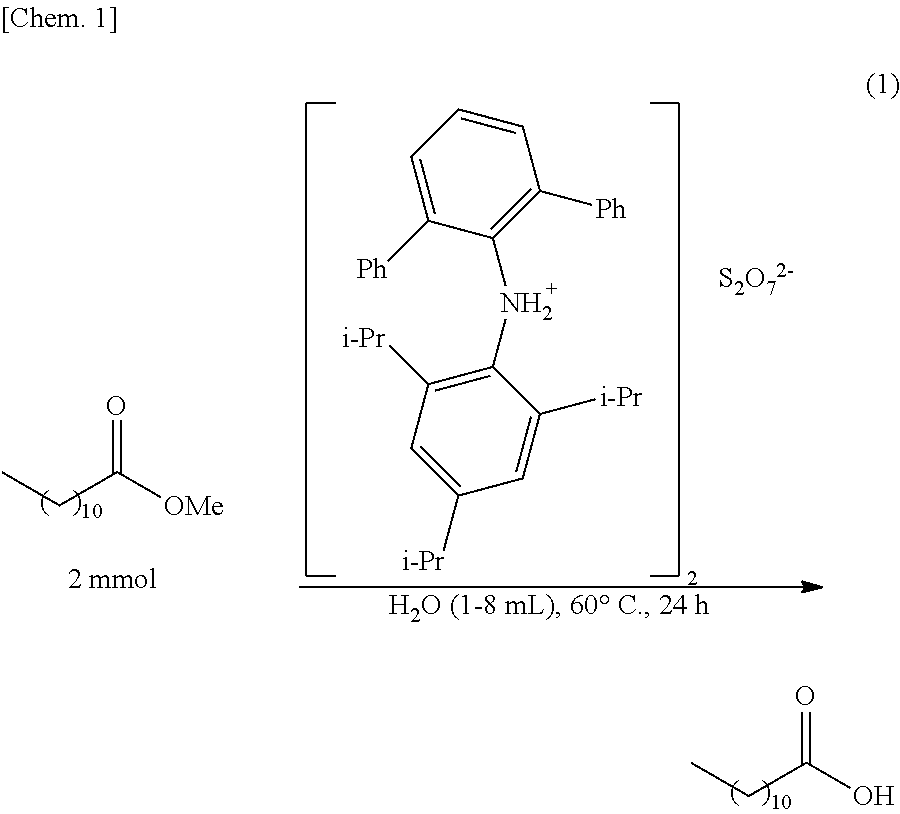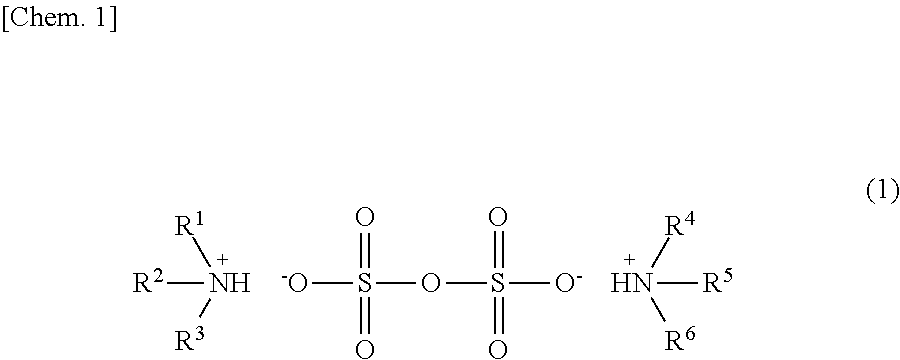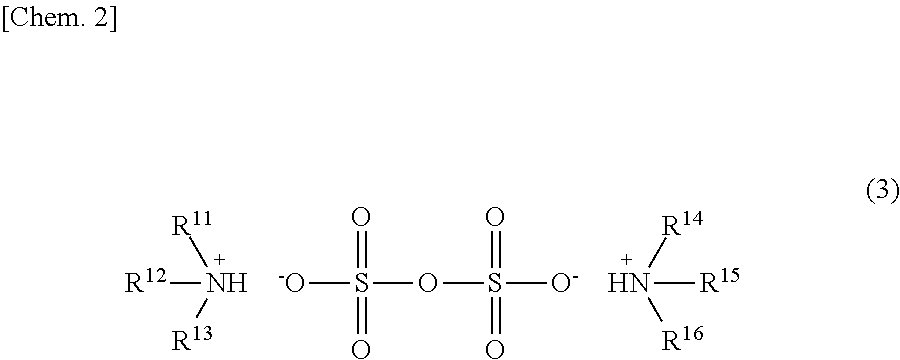Method for producing carboxylic acid and alcohol by hydrolysis of ester
a technology of carboxylic acid and ester, which is applied in the direction of physical/chemical process catalysts, bulk chemical production, organic compound/hydride/coordination complex catalysts, etc., can solve the problems of unstable stability of the above hydrolysis method and the high cost of organic solvents, and achieve excellent hydrolysis activity of the carboxylic acid ester, high yield, and efficient production
- Summary
- Abstract
- Description
- Claims
- Application Information
AI Technical Summary
Benefits of technology
Problems solved by technology
Method used
Image
Examples
example 1
Preparation of Ammonium Pyrosulfate Catalyst
(1) First Manufacturing Method
[0070]
[0071]As shown in the above formula (6), after N,N-diarylamine (0.10 mmol, 5 mol %) and sulfuric acid (0.10 mmol, mol %) were weighed in a flask and were then dissolved in 1,4-dioxane (0.1 mL), stirring was performed at 80° C. for 30 minutes. After the mixture thus obtained was cooled to room temperature, 1,4-dioxane was distilled off under reduced pressure. The ammonium pyrosulfate thus obtained was analyzed by 1H NMR (CD3CN). The chemical shifts (ppm) thereof are shown below.
[0072]δ 0.89 (d, J=6.9 Hz, 12H), 1.07 (d, J=6.9 Hz, 6H), 2.63 (septet, J=6.9 Hz, 1H), 2.86 (septet, J=6.9 Hz, 2H), 6.57 (s, 2H), 7.01 (t, J=7.3 Hz, 1H), 7.10 (d, J=7.3 Hz, 2H), 7.18-7.31 (m, 10H), 9.01 (s, 2H).
(2) Second Manufacturing Method
[0073]Except that 30% SO3-containing fuming sulfuric acid was used instead of sulfuric acid, and the temperature was set to room temperature (20° C.), production was performed in a manner simila...
example 2
Production of Lauric Acid (and Methanol) by Hydrolysis of Methyl Laurate
[0077]After methyl laurate (2 mmol) and water (1 to 8 mL) were added to the ammonium pyrosulfate catalyst (5 mol %) obtained in Example 1(1), heating was performed at 60° C. for 24 hours while stirring was performed, so that a hydrolysis reaction of methyl laurate was performed. The reaction mixture thus obtained was partly sampled and was analyzed by 1H NMR (CDCl3), so that the yield of lauric acid was calculated. The chemical shifts (ppm) are shown below. In addition, the results are shown in Table 1.
[0078]Methyl laurate: δ 0.88 (t, J=6.6 Hz, 3H), 1.29 (m, 16H), 1.62-1.65 (m, 2H), 2.30 (t, J=7.5 Hz, 2H), 3.66 (s, 3H)
[0079]Lauric acid: δ 0.89 (t, 3H), 1.16-1.37 (m, 16H), 1.64 (q, J=7.3, 2H), 2.35 (t, J=7.3 Hz, 2H)
[0080]
TABLE 1Amount of water (mL)1248Yield (%)55667386
[0081]As apparent from Table 1, it is found that when the amount of water to be used with respect to 2 mmol of methyl laurate is increased, the yie...
example 3
Production of Carboxylic Acid and Water-Soluble Alcohol by Hydrolysis of Carboxylic Acid Ester
[0085]As shown in the following Table 3, by using carboxylic acid esters, each of which produced a water-soluble alcohol, a hydrolysis reaction of a carboxylic acid ester was performed. That is, 1 mmol of the carboxylic acid ester and 4 mL of water were added to the ammonium pyrosulfate catalyst (5 mol %) obtained in Example 1(1), and the mixture was heated at 60° C. to 80° C. for 24 to 48 hours while stirring was performed. The reaction mixture thus obtained was partly sampled and was analyzed by 1H NMR (CDCl3), and by comparison between the following signals, the yield of a carboxylic acid was calculated. The chemical shifts (ppm) are shown below. In addition, the results are shown in Table 3.
[0086]1. Ethyl laurate: δ 2.29 (t, J=7.7 Hz, 2H)
[0087]Lauric acid: δ 2.35 (t, J=7.3 Hz, 2H)
[0088]2. Isopropyl laurate: δ 2.25 (t, J=7.5 Hz, 3H)
[0089]Lauric acid: δ 2.35 (t, J=7.3 Hz, 2H)
[0090]3. Ethy...
PUM
| Property | Measurement | Unit |
|---|---|---|
| temperature | aaaaa | aaaaa |
| temperature | aaaaa | aaaaa |
| temperature | aaaaa | aaaaa |
Abstract
Description
Claims
Application Information
 Login to View More
Login to View More - R&D
- Intellectual Property
- Life Sciences
- Materials
- Tech Scout
- Unparalleled Data Quality
- Higher Quality Content
- 60% Fewer Hallucinations
Browse by: Latest US Patents, China's latest patents, Technical Efficacy Thesaurus, Application Domain, Technology Topic, Popular Technical Reports.
© 2025 PatSnap. All rights reserved.Legal|Privacy policy|Modern Slavery Act Transparency Statement|Sitemap|About US| Contact US: help@patsnap.com



